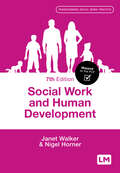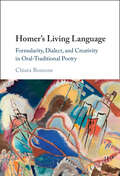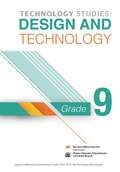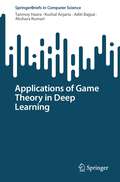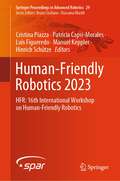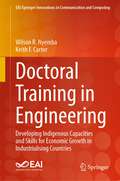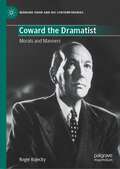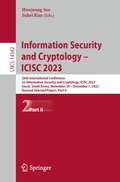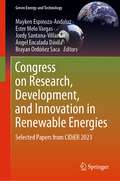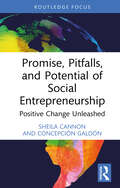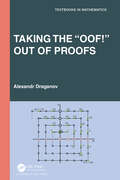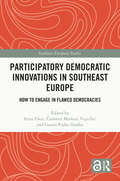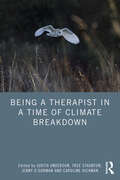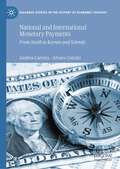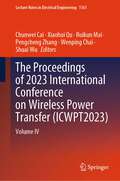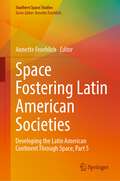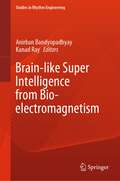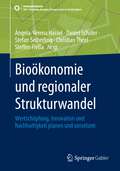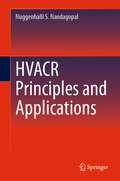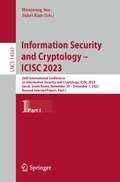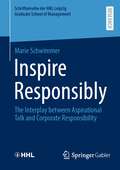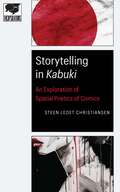- Table View
- List View
Social Work and Human Development (Transforming Social Work Practice Series)
by Janet Walker Nigel HornerSocial work engages with people across the life course, and social workers are expected to work with groups of people at very different stages of their life. Developing a thorough understanding of human growth to encompass the whole of the life course is therefore a central part of all qualifying social work training and practice. A clear favourite among students and lecturers, this bestselling book introduces the main theoretical models in a clear and accessible way before applying them to various stages of the life course. From infants to older adults, the authors use case studies and practice examples to bring social work methods, skills and principles to life.
Homer's Living Language: Formularity, Dialect, and Creativity in Oral-Traditional Poetry
by null Chiara BozzoneWhat if formularity, meter, and Kunstsprache in Homer weren't abstract, mechanical systems that constrained the poet's freedom, but rather adaptive technologies that helped poets to sustain feats of great creativity? This book explores this hypothesis by reassessing the key formal features of Homer's poetic technique through the lenses of contemporary linguistics and the cognitive sciences, as well as by drawing some unexpected parallels from the contemporary world (from the dialects of English used in popular music, to the prosodic strategies employed in live sports commentary, to the neuroscience of jazz improvisation). Aimed at Classics students and specialists alike, this book provides thorough and accessible introductions to the main debates in Homeric poetics, along with new and thought-provoking ways of understanding Homeric creativity.
Technology Studies: Design And Technology class 9 - MIE
by Mauritius Institute of EducationDesigned for Grade 9 students following the National Curriculum Framework for Nine-Year Continuous Basic Education, this textbook delves into the realm of Design and Technology. Covering various topics such as Green Design, Pictorial Projection, and Material Technology, its primary focus is to cultivate students’ understanding of design concepts, technological appreciation, and practical skills in bringing designs to life. Structured with clear learning objectives, engaging activities, and hands-on projects, the textbook adopts an incremental approach to learning, ensuring students grasp concepts progressively and can apply them effectively. Through this pedagogical framework, students are encouraged to explore the intersection of creativity and technology, fostering a deeper appreciation for the role of design in shaping the world around them.
Applications of Game Theory in Deep Learning (SpringerBriefs in Computer Science)
by Tanmoy Hazra Kushal Anjaria Aditi Bajpai Akshara KumariThis book aims to unravel the complex tapestry that interweaves strategic decision-making models with the forefront of deep learning techniques. Applications of Game Theory in Deep Learning provides an extensive and insightful exploration of game theory in deep learning, diving deep into both the theoretical foundations and the real-world applications that showcase this intriguing intersection of fields. Starting with the essential foundations for comprehending both game theory and deep learning, delving into the individual significance of each field, the book culminates in a nuanced examination of Game Theory's pivotal role in augmenting and shaping the development of Deep Learning algorithms. By elucidating the theoretical underpinnings and practical applications of this synergistic relationship, we equip the reader with a comprehensive understanding of their combined potential. In our digital age, where algorithms and autonomous agents are becoming more common, the combination of game theory and deep learning has opened a new frontier of exploration. The combination of these two disciplines opens new and exciting avenues. We observe how artificial agents can think strategically, adapt to ever-shifting environments, and make decisions that are consistent with their goals and the dynamics of their surroundings. This book presents case studies, methodologies, and real-world applications.
Human-Friendly Robotics 2023: HFR: 16th International Workshop on Human-Friendly Robotics (Springer Proceedings in Advanced Robotics #29)
by Cristina Piazza Patricia Capsi-Morales Luis Figueredo Manuel Keppler Hinrich SchützeComprising sixteen independent chapters, this book covers recent advancements and emerging pathways within human-friendly robotics on physical and cognitive levels. Each chapter presents a novel work presented at HFR 2023 by researchers from various robotic domains, where new theories, methodologies, technologies, challenges, and empirical and experimental studies are discussed. The multidisciplinary nature of the authors enriches the compilation with varied viewpoints, making it an excellent resource for academics, researchers, and industry professionals to get acquainted with the state of the art on human-robot interaction.
Doctoral Training in Engineering: Developing Indigenous Capacities and Skills for Economic Growth in Industrialising Countries (EAI/Springer Innovations in Communication and Computing)
by Wilson R. Nyemba Keith F. CarterThe book provides a comprehensive analysis of Engineering Education in industrialising countries, with Southern Africa as the case study, benchmarked on institutions from the industrialised world, with UK institutions as the reference. This was motivated by the perennial shortage of engineers and engineering skills to drive industry in Southern Africa, compounded by the mismatch of skills between those produced by tertiary institutions and those required by industry. This book focuses on the insufficiencies in training, through addressing the gap where the majority of engineering academics’ qualifications at MSc/MEng level fall short of the internationally acceptable PhD/DEng/DTech. In order to address such insufficiencies, the book proposes and advocates for reskilling and doctoral training of engineering academics through the proposed and established DTCs within the region. The book is targeted at graduate students, engineering academics, researchers, university administrators, foreign aid agencies, captains of industry and policy-makers in governments. To all these readers, the book offers:
Coward the Dramatist: Morals and Manners (Bernard Shaw and His Contemporaries)
by Roger KojeckyDiscussions of Coward’s achievement in the theatre between 1920 and 1966 have tended to stay with the colourful biography. The more analytical literary approach adopted here places Coward’s success in its wider theatrical context, making the connections with the work of other dramatists. He developed his technique according to what worked with theatre audiences. Taking up the well-made play, he brought in a more colloquial dialogue, explored, for instance, the morality and psychology of marriage and free love, and frequently exploited the dramatic possibilities of characters grouped into two camps. The book considers both the ‘pleasant’ and ‘unpleasant’ plays (to use the Shavian terms), and the episodic patriotic plays. It Includes Coward’s ambivalent approach to the ‘theatre of war’ in the 20th century. (123)
The Palgrave Handbook of Christianity in Africa from Apostolic Times to the Present
by Andrew Eugene Barnes Toyin FalolaThis comprehensive Handbook provides chapter length surveys of the history of Christian missions and Christian churches on the African continent since the time of Christ. Africa is rapidly becoming the most Christianized region of the world. While common narratives about Christianity tend to present Christianity as a set of ideas and beliefs imposed on Africa from the outside, such narratives hold little meaning for African Christians or for those seeking to understand Christianity in Africa as an indigenous faith. The aim of the Handbook is to propose a set of scholarly starting points for a new set of narratives. The chapters collected here communicate an idea of Christianity as it has been embraced among African peoples at particular historical moments. It therefore grants voice to the various strands of African Christianity on their own terms, and offers scholarly study of what these voices teach us about how the world’s most adhered to religion is practiced and understood on the continent of Africa.
Information Security and Cryptology – ICISC 2023: 26th International Conference on Information Security and Cryptology, ICISC 2023, Seoul, South Korea, November 29 – December 1, 2023, Revised Selected Papers, Part II (Lecture Notes in Computer Science #14562)
by Hwajeong Seo Suhri KimThis book constitutes the refereed proceedings of the 26th International Conference on Information Security and Cryptology on Information Security and Cryptology – ICISC 2023, held in Seoul, South Korea, during November 29–December 1, 2023The 31 full papers included in this book were carefully reviewed and selected from 78 submissions. They were organized in topical sections as follows:Part I: Cryptanalysis and Quantum Cryptanalysis; Side Channel Attack; Signature Schemes.Part II: Cyber Security; Applied Cryptography; and Korean Post Quantum Cryptography.
Congress on Research, Development, and Innovation in Renewable Energies: Selected Papers from CIDiER 2023 (Green Energy and Technology)
by Mayken Espinoza-Andaluz Ester Melo Vargas Jordy Santana-Villamar Ángel Encalada Dávila Brayan Ordóñez SacaThe 2023 Congress on Research, Development, and Innovation in Renewable Energies (CIDiER 2022) promotes international collaboration fostering ideas and dialogue around solutions to climate change through research and development that leads to clean energy innovation via renewable energies. These selected papers cover theoretical and applied research that will strengthen the implementation of renewable energy projects between universities, research centers, and private companies in Latin America.
Promise, Pitfalls, and Potential of Social Entrepreneurship: Positive Change Unleashed (Routledge COBS Focus on Responsible Business)
by Sheila Cannon Concepción GaldónThis book dives into the heart of social entrepreneurship as the authors share the latest research, global experiences, authentic private conversations, and diverse narratives around this widely popular concept. The idea and practice of social entrepreneurship has swept the world, taken up with enthusiasm by business leaders, nonprofit practitioners, and public policy makers alike. In this book, the authors argue that social entrepreneurship is surrounded by great promise, and that this high expectation has contributed to its pitfalls, setting it out as separate and different from other kinds of nonprofit organising, public service provision, and business for social benefit. After exploring the problem of inflated expectations, the authors rescue the concept from perfection – overly positive normative judgements – by presenting practical ways forward. The book sets out how to really unleash the power of social entrepreneurship so that it can actually deliver on its promise to improve how we organise for social purpose. This potential revolves around four key themes that are levers for social change: innovative individuals, social impact, scaling social enterprises, and the power of ecosystems. Through these themes, the book covers a wide range of approaches to social enterprise illustrated by specific examples and experiences from five continents. This accessible book is a valuable resource for a variety of practitioners, upper-level students, instructors, and business scholars, particularly those with an interest in social/environmental impact, entrepreneurship, business ethics, sustainable business, ESG and CSR.
Taking the “Oof!” Out of Proofs (Textbooks in Mathematics)
by Alexandr DraganovThis book introduces readers to the art of doing mathematical proofs. Proofs are the glue that holds mathematics together. They make connections between math concepts and show why things work the way they do. This book teaches the art of proofs using familiar high-school concepts, such as numbers, polynomials, functions, and trigonometry. It retells math as a story, where the next chapter follows from the previous one.Readers will see how various mathematical concepts are tied and will see that mathematics is not a pile of formulas and facts; rather, it has an orderly and beautiful edifice.The author begins with basic rules of logic and then progresses through the topics already familiar to the students: numbers, inequalities, functions, polynomials, exponents, and trigonometric functions. There are also beautiful proofs for conic sections, sequences, and Fibonacci numbers. Each chapter has exercises for the reader.Reviewer Comments:I find the book very impressive. The choice and sequence of topics is excellent, and it is wonderful to have all of these things together in one volume. Theorems are clearly stated, and proofs are accurate. – Michael ComenetzThe thoroughness of the narrative is one of the main strengths of the book. The book provides a perfect illustration of mathematical thinking. Each step of a given derivation is precise and clear. – Julie GershunskayaDraganov’s book stands out from the many competing books. Draganov’s goal is to show that mathematics depends on the notion of proof. Unlike other transition books, he addresses mathematical topics at an accessible level, rather than topics studied later in the university curriculum. – Ken Rosen
Participatory Democratic Innovations in Southeast Europe: How to Engage in Flawed Democracies (ISSN)
by Irena Fiket Čedomir Markov Vujo Ilić Gazela Pudar DraškoThis volume strengthens the dialogue between conceptual perspectives, approaches and fields on deliberative and participatory forms of democratic innovation and offers novel insights, focusing on the Southeast European space. Traditional forms of participation seem insufficient in satisfying the growing complexity of the democratic processes, especially in the context of autocratizing societies. It is crucial to examine the possibilities of democratic innovation in political research and practice, trying to establish a connection between the possibilities and limits of representative democracy and social movements as possible carriers of the process of democratic innovation. This book offers novel insights into practices of civil society and social movements and their pathways carved to initiate a deep change in political thinking and practice and compelling insights for scholars and students of Southeast Europe, social movements and democracy.
Being a Therapist in a Time of Climate Breakdown
by Judith Anderson Tree Staunton Jenny O’Gorman Caroline HickmanThis book introduces readers to the known psychological aspects of climate change as a pressing global concern and explores how they are relevant to current and future clinical practice.Arguing that it is vital for ecological concerns to enter the therapy room, this book calls for change from regulatory bodies, training institutes and individual practitioners. The book includes original thinking and research by practitioners from a range of perspectives, including psychodynamic, eco-systemic and integrative. It considers how our different modalities and ways of working need to be adapted to be applicable to the ecological crises. It includes Voices from people who are not practitioners about their experience including how they see the role of therapy. Chapters deal with topics from climate science, including the emotional and mental health impacts of climate breakdown, professional ethics and wider systemic understandings of current therapeutic approaches. Also discussed are the practice-based implications of becoming a climate-aware therapist, eco-psychosocial approaches and the inextricable links between the climate crises and racism, colonialism and social injustice. Being a Therapist in a Time of Climate Breakdown will enable therapists and mental health professionals across a range of modalities to engage with their own thoughts and feelings about climate breakdown and consider how it both changes and reinforces aspects of their therapeutic work.
National and International Monetary Payments: From Smith to Keynes and Schmitt (Palgrave Studies in the History of Economic Thought)
by Andrea Carrera Alvaro CenciniThis book demonstrates the relevance of the historical perspective with respect to national and international payment systems. Its analysis of national and international payments develops along a dialectical path that starts with the work of the Classics (thesis), undergoes a radical turn with the advent of the neoclassical school (antithesis), and reaches the modern theory of emissions passing through Keynes’s contribution (synthesis). That the history of economic thought occupies a legitimate place in the field of historical studies is beyond dispute. What may be less well understood is that it can serve purposes beyond those of the academic community of historians.This book critically investigates the contributions of the greatest economists of the past to provide insights into the pathologies of today’s systems of national and international payments and into the reforms that are needed to correct them. It will be relevant to students and researchers interested in economicpolicy and the history of economic thought.
The Proceedings of 2023 International Conference on Wireless Power Transfer: Volume IV (Lecture Notes in Electrical Engineering #1161)
by Chunwei Cai Xiaohui Qu Ruikun Mai Pengcheng Zhang Wenping Chai Shuai WuThis book includes original, peer-reviewed research papers from the 2023 International Conference on Wireless Power Transfer (ICWPT2023), held in Weihai, China. The topics covered include but are not limited to: wireless power transfer technology and systems, coupling mechanism and electromagnetic field of wireless power transfer systems, latest developments in wireless power transfer system, and wide applications. The papers share the latest findings in the field of wireless power transfer, making the book a valuable asset for researchers, engineers, university students, etc.
Space Fostering Latin American Societies: Developing the Latin American Continent Through Space, Part 5 (Southern Space Studies)
by Annette FroehlichThis peer-reviewed book presents a comprehensive overview of the role space is playing in enabling Latin America to fulfil its developmental aspirations. Following on from the highly acclaimed Parts 1 to 4, it explains how space and its applications can be used to support the development of the full range and diversity of Latin America societies, while being driven by Latin American goals. The Latin American space sector is currently undergoing a phase of rapid and dynamic expansion, with new actors entering the field and with space applications increasingly being used to support the continent’s social, economic, and political development. All across Latin America, attention is shifting to space as a fundamental part of the continental development agenda, and the creation of a Latin American space agency is evidence of this. Additionally, while in recent years, significant advances in economic and social development have lifted many of Latin America’s people out of poverty, there is still much that needs to be done to fulfil the basic needs of the population and to afford them the dignity they deserve. To this end, space is already being employed in diverse fields of human endeavour to serve Latin America’s goals for its future, but there is still a need for further incorporation of space systems and data. This book will appeal to researchers, professionals and students in fields such as space studies, international relations, governance, and social and rural development.
Origami Antennas for Wireless Communication Systems
by Syed Imran Shah Shahid Bashir Slawomir KozielThis book discusses the lightweight, reconfigurable, and deployable origami antennas for adaptive communication systems. Traditional antennas, with their fixed characteristics, struggle to meet the evolving needs of modern communication systems. Reconfigurable antennas, on the other hand, can dynamically adjust their operating parameters, offering significant advantages in terms of performance, size, and cost. Origami technology has emerged as a disruptive force in antenna design, enabling the development of lightweight, reconfigurable antennas with tailored radiation characteristics. Deployable origami antennas offer a transformative solution for applications demanding mobility and rapid deployment in challenging environments. These innovative antennas hold immense promise to revolutionize communication systems, paving the way for a future where adaptability and versatility are paramount. This book offers a comprehensive guide to origami antenna technology, encompassing both fundamentals and practical applications. It might be a valuable resource for researchers and engineers working in the field of antenna development, particularly those focused on wireless communication systems with reconfigurability and deployability are essential design prerequisites.
Brain-like Super Intelligence from Bio-electromagnetism (Studies in Rhythm Engineering)
by Anirban Bandyopadhyay Kanad RayThis book discusses various aspects of bioinspired technologies but with an additional emphasis on the medical science, starting from the popular article on neurobiology to pure biophysics that ends with the superintelligence of biological systems that could be reverse engineered. It covers eight different aspects of natural intelligence, starting from the fundamental electromagnetic properties of a protein to the vibrations and the resonance of the entire biomaterial system. It also covers a wide spectrum of hierarchical communication among different biological systems for intelligence and then medical science is applied.
Bioökonomie und regionaler Strukturwandel: Wertschöpfung, Innovation und Nachhaltigkeit planen und umsetzen (SDG - Forschung, Konzepte, Lösungsansätze zur Nachhaltigkeit)
by Angela-Verena Hassel Daniel Schiller Stefan Seiberling Christian Theel Steffen FleßaBioökonomie ist eine neue branchenübergreifende Form des Wirtschaftens, die das Potenzial hat, die bisherige Ökonomie und einzelne Regionen grundlegend zu verändern. Dieser Überzeugung folgend stellen die Herausgeber und Autoren dieses Buches den aktuellen Wissenstand aus Theorie und Praxis der Bioökonomie zusammen, entwickeln neue Methoden für einen bioökonomischen Strukturwandel und reflektieren bestehende Bioökonomiekonzepte. Der komplexe und vielschichtige Prozess einer pflanzenbasierten Bioökonomie in ländlichen Räumen wird aus unterschiedlichen Perspektiven betrachtet. Zunächst werden ökonomische Grundlagen sowohl aus gesamt- als auch aus einzelwirtschaftlicher Sicht diskutiert. Dem schließen sich Beispiele an, wie regionale Innovationsnetzwerke und Wertschöpfungsketten der Bioökonomie einen Beitrag zur nachhaltigen Regionalentwicklung und zum gesellschaftlichen Wandel leisten können. Die darauf aufbauende Analyse legt dar, wie verschiedene Akteure und Prozesse eine regionale Bioökonomie in der Praxis etablieren können. Ausgewählte Anwendungs- und Umsetzungsbeispiele für Innovationen pflanzenbasierter Bioökonomie im nordöstlichen Mecklenburg-Vorpommern runden das Buch ab und zeigen das Potenzial für eine Transformation der Wirtschaft in der Region und darüber hinaus.
HVACR Principles and Applications
by Nuggenhalli S. NandagopalThis book provides a clear and concise understanding of the principles and applications of HVACR using a rigorous, yet, easy to follow presentation. The coverage is broad, including relevant support areas such as fluid mechanics, heat transfer, thermodynamics, psychrometrics, with specific applications to HVACR design and calculations, and main topics such as air conditioning processes, cooling / heating load calculations, refrigeration cycles, and HVACR equipment and systems. The book integrates and illustrates the use of data and information from ASHRAE Handbooks and Standards in step-by-step calculations of cooling and heating loads and other aspects of HVACR. Elucidation of the principles is further reinforced by examples and practice problems with detailed solutions. Firmly grounded in the fundamentals, the book maximizes readers’ capacity to take on new problems and challenges in the field of HVACR with confidence and conviction. Providing a ready reference and review of essential principles and their applications in HVACR, the book is ideal for HVACR practitioners, undergraduate engineering students, and those specializing in HVACR, as well as for practicing engineers preparing for the engineering license exams (FE and PE) in USA and abroad. The book uses both Inch-Pound (I-P) and S I systems of units to facilitate global readership and use.
Wachstum durch den Einsatz von Generativer KI: Funktionsweise und Anwendungsgebiete im Marketing (essentials)
by Bernhard WeckeDieses Buch bietet einen fundierten Einblick in die Relevanz von Generativer Künstlicher Intelligenz (KI) im Marketing. Neben einer kompakten Darstellung der Funktionsweise und Grenzen von Generativer KI wird ein umfassender Überblick über KI-basierte Medienformate gegeben.Anhand von Praxisbeispielen und konkreten Auswahlkriterien erfahren Sie, wie Sie geeignete Anwendungsfälle für Generative KI identifizieren und in Ihre Marketingstrategie integrieren können. .
Information Security and Cryptology – ICISC 2023: 26th International Conference on Information Security and Cryptology, ICISC 2023, Seoul, South Korea, November 29 – December 1, 2023, Revised Selected Papers, Part I (Lecture Notes in Computer Science #14561)
by Hwajeong Seo Suhri KimThis book constitutes the refereed proceedings of the 26th International Conference on Information Security and Cryptology on Information Security and Cryptology – ICISC 2023, held in Seoul, South Korea, during November 29–December 1, 2023The 31 full papers included in this book were carefully reviewed and selected from 78 submissions. They were organized in topical sections as follows:Part I: cryptanalysis and quantum cryptanalysis; side channel attack; signature schemes.Part II: cyber security; applied cryptography; and korean post quantum cryptography.
Inspire Responsibly: The Interplay between Aspirational Talk and Corporate Responsibility (Schriftenreihe der HHL Leipzig Graduate School of Management)
by Marie SchwimmerAspirational talk has gained increasing research attention as a compelling concept theoretically explaining the potential of talk-action discrepancies in corporate responsibility communication to instigate organizational change. Under certain conditions, aspirational talk can facilitate discourse, agreement, reframing, and corporate reflexivity. However, perceived talk-action discrepancies can negatively affect organizational members, leading to disengagement, and demotivation, causing emotional exhaustion, exposing employees to vulnerabilities, and even catalyzing unethical or illicit behaviors. Thus, this book focuses on how aspirational talk becomes irresponsible in an organizational context, and how it can be avoided. The author proposes that aspirational talk becomes irresponsible if it creates expectations that lead to illegitimate harm to employees or involved stakeholders. A framework is derived, constituting the finding that it takes two types of investments into performativity and responsibility conditions, to avoid the irresponsible use of aspirational talk – and thus, to inspire responsibly.
Storytelling in Kabuki: An Exploration of Spatial Poetics of Comics (Encapsulations: Critical Comics Studies)
by Steen Ledet ChristiansenSteen Ledet Christiansen&’s Storytelling in &“Kabuki&” explores the series created by David Mack—a slow, recursive narrative that focuses on the death of Kabuki and her past. The series ran from 1994 to 2004 in a variety of miniseries, one-shots, and spin-offs, rather than following a conventional American monthly release schedule. Most of the series explores different perspectives on the same event and adds background to Kabuki&’s past, usually through surreal sequences, dreams, and near-death experiences. The flexibility of comics&’ approach to chronology, space, focalization, narrative, and fictionality enabled Mack to produce an unusual experience. Kabuki tells a story that can only exist via comics. Christiansen analyzes the visual design of the series, a heterogeneous collection of styles depending on the story. To understand Kabuki, it is crucial to explore the visual styles, as well as the use of visual and spatial rhymes and mixed media forms. Because Kabuki employs a complex layering of focalizations, diegetic levels, and metafictional self-reflectivity that is rare in mainstream American comics, it utilizes a narrative poetics that focuses on constant repeating, restating, and returning to the same events.Kabuki&’s unique compositional layering allows Christiansen to provide a clear example of how comics work while also expanding on critical vocabulary, especially in terms of spatial poetics. By exploring spatial form, Christiansen illuminates and gives a critical framework to a different and underexamined aspect of comics.
